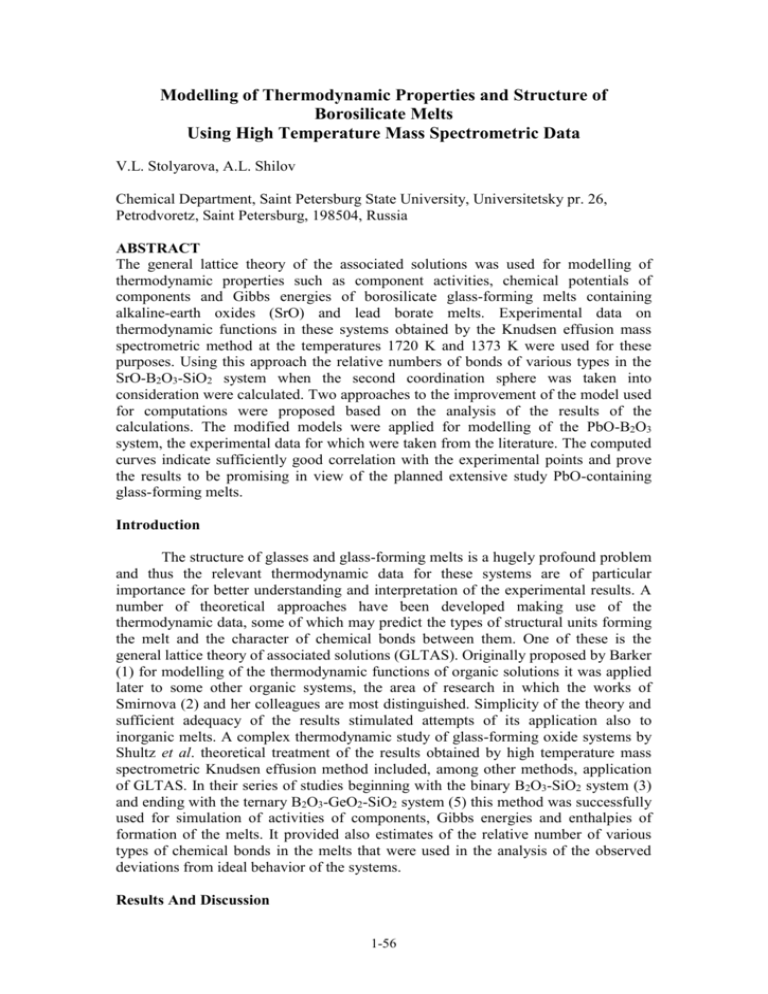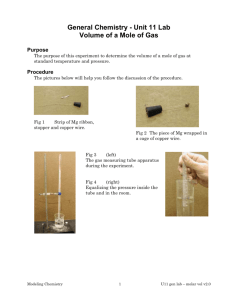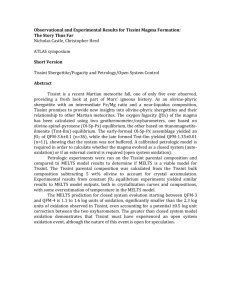MODELING OF THERMODYNAMIC PROPERTIES AND
advertisement

Modelling of Thermodynamic Properties and Structure of
Borosilicate Melts
Using High Temperature Mass Spectrometric Data
V.L. Stolyarova, A.L. Shilov
Chemical Department, Saint Petersburg State University, Universitetsky pr. 26,
Petrodvoretz, Saint Petersburg, 198504, Russia
ABSTRACT
The general lattice theory of the associated solutions was used for modelling of
thermodynamic properties such as component activities, chemical potentials of
components and Gibbs energies of borosilicate glass-forming melts containing
alkaline-earth oxides (SrO) and lead borate melts. Experimental data on
thermodynamic functions in these systems obtained by the Knudsen effusion mass
spectrometric method at the temperatures 1720 K and 1373 K were used for these
purposes. Using this approach the relative numbers of bonds of various types in the
SrO-B2O3-SiO2 system when the second coordination sphere was taken into
consideration were calculated. Two approaches to the improvement of the model used
for computations were proposed based on the analysis of the results of the
calculations. The modified models were applied for modelling of the PbO-B2O3
system, the experimental data for which were taken from the literature. The computed
curves indicate sufficiently good correlation with the experimental points and prove
the results to be promising in view of the planned extensive study PbO-containing
glass-forming melts.
Introduction
The structure of glasses and glass-forming melts is a hugely profound problem
and thus the relevant thermodynamic data for these systems are of particular
importance for better understanding and interpretation of the experimental results. A
number of theoretical approaches have been developed making use of the
thermodynamic data, some of which may predict the types of structural units forming
the melt and the character of chemical bonds between them. One of these is the
general lattice theory of associated solutions (GLTAS). Originally proposed by Barker
(1) for modelling of the thermodynamic functions of organic solutions it was applied
later to some other organic systems, the area of research in which the works of
Smirnova (2) and her colleagues are most distinguished. Simplicity of the theory and
sufficient adequacy of the results stimulated attempts of its application also to
inorganic melts. A complex thermodynamic study of glass-forming oxide systems by
Shultz et al. theoretical treatment of the results obtained by high temperature mass
spectrometric Knudsen effusion method included, among other methods, application
of GLTAS. In their series of studies beginning with the binary B2O3-SiO2 system (3)
and ending with the ternary B2O3-GeO2-SiO2 system (5) this method was successfully
used for simulation of activities of components, Gibbs energies and enthalpies of
formation of the melts. It provided also estimates of the relative number of various
types of chemical bonds in the melts that were used in the analysis of the observed
deviations from ideal behavior of the systems.
Results And Discussion
1-56
As a further development of GLTAS we have tested applicability of this
method to borosilicate melts containing alkaline-earth oxides CaO, SrO, and BaO.
The best results of modeling were obtained for the SrO-B2O3-SiO2 system, the mass
spectrometric experimental data for which was found in (5). The simulated
thermodynamic functions for this system in comparison with the experimental data
a
c
b
d
Fig.1. Experimental (dashed curves) and calculated (solid curves) thermodynamic
functions for the melts of the SrO-B2O3-SiO2 system at 1720 K. The numbers above
the isoactivity lines are the values of: a – ln(aB2O3), b – ln(aSiO2), c – ln(aSrO). In Fig.1,
d the numbers denote the lines of constant Gibbs energy (kJ/mole) of formation in the
system under study.
are plotted in Fig.1, and the relative numbers of bonds of various types are shown in
Fig.2.
The curves in Fig.1 indicate that in some regions of the triangles the accuracy
of the theoretical approximation is inadequately low and despite the large number of
the variable parameters used (nine) better fitting curves can hardly be constructed: due
to the constraints imposed by GLTAS the results of the calculations are always
smooth curves similar to those in Fig.1, so that strong abnormalities in the behavior of
thermodynamic functions can not be simulated. The strongest deviation from the
experimental results exhibited the BaO-B2O3-SiO2 system. Considerable discrepancy
has to be expected, certainly, bearing in mind the complexity of structural
transformations typical for oxide melts. Nevertheless, in our opinion, even without
any further fundamental development of GLTAS, simply by a modification of
1-57
Relative number of bonds of different types
computational procedure, the results may be improved considerably. Two of such
optional algorithms were tested and are reported here. First, the basic ideas of GLTAS
will be outlined following Barker (1).
This theory is based on the quasi-chemical approximation from which the
numbers of interactions of various types in the equilibrium configuration of the
0,5
0,4
6
7
5
0,3
4
3
0,2
2
1
9
0,1
8
0,0
0
0,2
0,4
0,6
x (B2O3)/(1 - x (SrO))
0,8
1
Fig.2. Variation of the relative number of bonds of different types in the melts of the
SrO-B2O3-SiO2 system: 1 – B-O[B], 2 – Si-O[Si], 3 – B-O[Si], 4 – B-O[Sr], 5 – SiO[Sr], 6 – Sr-O[B], 7 – Sr-O[Si], 8 – Si-O[B] (×5), 8 – Si-O[B] (×50), 9 – Sr-O[Sr]
(×5); x(SrO) = 0.5 mole fraction.
system (melt)are deduced. Some structural information is required to choose a
simulation model, i.e. a lattice with appropriate coordination number z and structural
units A, B, … corresponding to the components of the system, which are regarded as
molecules occupying rA, rB, … sites of the lattice. The surface of these ‘molecules’ is
divided into cA, cB, … contact points in accordance with the number of neighboring
sites:
cA = rAz – 2rA + 2 .
(1)
A system of equations for a set of the auxiliary unknown variables XμA is then
formulated:
XμA ∑ ημνAB XνB = QμA xA / 2 ,
(2)
where xA is the mole fraction of the A component, QμA is the number of μ-type contact
point of the A component, ημνAB is the energy parameters of the model related to free
energy of exchange UμνAB of the μ- and ν-type contact points of the A and B structural
units as ημνAB = exp(-UμνAB/kT). The number of the unknowns XμA is equal to the
number of different types of contact points and hence to the number of equations (2).
For a particular composition and a selected set of energy parameters ημνAB system (2)
may be solved and the values of XμA found. Substitution of these values into eqn. (3)
NμνAB = 2 XμA XνB ημνAB N, [μA] ≠ [νB],
1-58
(3)
where NμνAB is the number of the μ- and ν-type contact points of the A and B structural
units, respectively, and N is the total number of the particles in the system, allows to
calculate the relative numbers of bonds of various types.
The energy parameters ημνAB may be determined by the best-fit procedure
using the appropriate experimental data. The values of the excess chemical potential
of the components derived in GLTAS are
ΔμEA = RT [∑QμAln(XμA/XμAp/xA)+rA(z/2-1)ln(∑rixi/rA)],
(4)
where XμAp is the solution of system (2) for pure component A. The optimal set of
energy parameters may be chosen by multiple substitutions of their trial values into
(4) and comparison of the resulting ΔμE(x) with the experimental dependencies.
For calculation of thermodynamic properties of the SrO-B2O3-SiO2 melts the
following model was accepted: on a 3-coordinated lattice structural units B2O3, SiO2,
and SrO are placed; SrO occupies one site of the lattice, B2O3 and SiO2 - two sites
each. The selected contact points on the surface of a structural unit refer either to its
element or to its oxygen atom. It is considered that all chemical bonds are realized
through atoms of oxygen and non-bridging oxygen do not exist in the melt.
To simplify the notation numbers 1, 2, 3 in the indices will denote the
structural units SiO2, B2O3, and SrO, respectively, and symbols of elements will
indicate the type of contact point to which the given value refers. (e.g., 1O is the
oxygen contact point of the structural unit SiO2 etc). Thus, r1 = r2 = 2, r3 = 1. The
numbers of contact points were taken as follows: Q1Si = 2, Q1O = 2, Q2B = 2, Q2O = 2,
Q3Sr = 2, Q3O = 1.
Non-linear system of equations (2) is symmetrical with respect to its diagonal
elements, that is ηi-k = ηk-i. Hence it can be written in a compact form as a product of
matrix Η = {ηi-k} of the coefficients of the system and vector X = (X1Si, X1O, X2B, X2O,
X3Sr, X3O)T of unknown variables (T denotes transposition):
(Η X)T X = ½ Q,
(5)
where vector Q is (x1Q1Si, x1Q1O, x2Q2B, x2Q2O, x3Q3Sr, x3Q3O)T, xi is the content of the
component i in the melt, and matrix Η has the form:
Η
1
η1Si-1O
1
η1Si-2O
1
η1Si-3O
η1Si-1O
1
η1O-2B
1
η1O-3Sr
1
1
η1O-2B
1
η2B-2O
1
η2B-3O
η1Si-2O
1
η2B-2O
1
η2O-3Sr
1
1
η1O-3Sr
1
η2O-3Sr
1
η3Sr-3O
η1Si-3O
1
η2B-3O
1
η3Sr-3O
1
(6)
n this notation eqns. (4) for the excess chemical potentials are:
ΔμE1= RT(2 ln(X1Si/X1Sip/x1)+2 ln(X1O/X1Op/x1)+ln((x1+x2+1)/2)),
(7)
ΔμE2= RT(2 ln(X2B/X2Bp/x2)+2ln(X2O/X2Op/x2)+ln((x1+x2+1)/2)),
(8)
1-59
ΔμE3= RT(2 ln(X3Sr/X3Srp/(1-x1-x2))+ln(X3O/X3Op/(1-x1-x2))+½ln(x1+x2+1)), (9)
where vector {Xikp} (k = Si, B, O, Sr) is the solution of the system (5) for pure i-th
component, i.e. for xi = 1.
Using this computational scheme the results shown in Fig.1 and Fig.2 were
obtained. For our test of modified methods we have chosen the binary PbO-B2O3
system, the sufficiently full experimental data for which could be borrowed from (6).
To have reference curves for comparison, calculations using the model similar to the
above described were performed. PbO and B2O3 (indices 1 and 2, the notation remains
as previous) were taken as the structural units in the 3-coordinated lattice, occupying
2 sites each, their numbers of contact points being Q1Pb = 3, Q1O = 1, Q2B = 2, Q2O = 2
(rPbO = 2 and Q1Pb = 3 were chosen according to the molar volume of lead oxide).
Then, vector X in eqn.(5) is (X1Pb, X1O, X2B, X2O)T, Q = (1.5x1Q1Pb, 0.5x1Q1O, x2Q2B,
x2)Q2O)T, matrix Η for the system of equations (5) could be written in the form:
Η
1
η1Pb-1O
1
η1Pb-2O
η1Pb-1O
1
η1O-2B
1
1
η1Pb-2O
1
η1Pb-2O
η1Pb-2O
1
η1Pb-2O
1
,
(10)
and excess chemical potentials of PbO and B2O3 were according to Barker (1):
ΔμE1 = RT(3 ln(X1Pb/X1Pbp/x1)+ln(X1O/X1Op/x1)),
(11)
ΔμE2 = RT(2 ln(X2B/X2Bp/x2)+2 ln(X2O/X2Op/x2)) .
(12)
Consistency of the parameters of the model is illustrated by the schematic lattice in
Fig.3, a.
The curves obtained by the approximation using equations (5), (11) and (12)
are shown in Fig.4 together with the reference experimental points. The system (5)
includes 4 different energy parameters. Since at high values of these parameters,
typical for oxide melts, the excess chemical potentials expressed by eqns. (11, 12) are
not sensitive to the absolute values of the Xik, one of the ηi-k parameters fixing the
energy scale for the whole set of the η values had to be taken from some other source.
This value corresponding to the B-O[B] bond, U= 125 kJ/mole, was taken from the
ref. (3), though in their later works the authors re-assessed it considerably. With this
regard the other energy parameters were as follows: Pb-O[Pb] - 215, Pb-O[B] - 260,
B-O[Pb] - 125 kJ/mole. The results shown in Fig.4 based on the parameters of model
described above we shall refer to as obtained by ‘the first approach’. All previous
calculations were performed using the first approach, that is, considering B2O3 as one
structural unit with 4 contact points and attributing all ‘element-type’ contact points to
the same class .
The most obvious way to improve the model and to drive the curves in Fig.4
closer to the experimental points is to increase the number of variable parameters by
attributing similar contact points different energies. In our case three Pb-contact
points of the PbO molecule may be divided into separate classes. One point (and the
corresponding energy parameters) may be interpreted then as producing a nonbridging oxygen atom O[B] and the other two as contributing to the integral energy of
interaction with oxygen atoms of the second coordination sphere.
1-60
1Pb
1O
2O
a
2B
2B
2O 2B
2O
1Pb
1Pb
1Pb
1O
2O
1Pb
1Pb
2B
2B
1Pb
1O
2O
2B
2O
2B
1Pb
1Pb
2B
2O
2O
2B
2B
1O
1Pb
1Pb 2O
1Pb
2O
1O
1O
1Pb
2O
2O
2B
2B
2O
1O
1Pb
1O
2B
2O
2B
3B
2O
2O
2B
2B
2B
2O
2B
2O
1O
1Pb
1O
1Pb
1Pb
3O
1O
1Pb
3B
2O
2B
1Pb
1Pb
3O
2B 3O
3O
1Pb 3O
1Pb
3B
1Pb
1O
1O
3O
2B
1O
1Pb
2O
3B
1Pb
1Pb
3O
2B
2B 3O
2O
1Pb
3O
1Pb
1Pb
1Pb
2B
2B
1Pb
1O
1Pb
1Pb
1Pb
b
3B
1Pb 3O
1O
3O
1Pb
3B
3O
3O
3O
2B
3B
2O
2B
1O
1Pb
1Pb
1O
Fig.3. Plane representation of the adopted structural model: a – lattice with PbO and
B2O3 structural units; b – lattice with PbO, BO, and BO2 structural units.
0
E
Dm , kJ/mole
-20
-40
-60
-80
-100
-120
0
0,2
0,4
0,6
0,8
1
x (PbO), mole fractions
Fig.4. Excess chemical potentials of components in the PbO-B2O3 melts as a function
of PbO concentration: solid line (ΔμEPbO) and dashed line (ΔμEB2O3) represent the
results calculated according to the first approach, ○ (ΔμEPbO) and □ (ΔμEB2O3) are
experimental values from ref. (3).
Thus let one of the lead contact points differ from the other two. We shall
distinguish it by the superscript, so that PbO has now two 1Pb contact point, one 1Pb’
and one 1O contact point. This will be referred to as the second approach. The model
parameters must be modified as follows:
Q1Pb = 2, Q1Pb’ = 1, Q1O = 1, Q2B = 2, Q2O = 2;
X = (X1Pb, X1Pb’, X1O, X2B, X2O)T;
Q = (x1Q1Pb, 0.5x1Q1Pb, 0.5x1Q1O, x2Q2B, x2Q2O)T;
ΔμE1 = RT(2 ln(X1Pb/X1Pbp/x1)+ln(X1Pb’/X1Pb’p/x1)+ln(X1O/X1Op/x1));
ΔμE2 = RT(2 ln(X2B/X2Bp/x2)+2 ln(X2O/X2Op/x2));
1-61
0
E
Dm , kJ/mole
-20
-40
-60
-80
-100
-120
0
0,2
0,4
0,6
0,8
1
x (PbO), mole fractions
Fig.5. Excess chemical potentials of components in the PbO-B2O3 melts as a function
of PbO concentration: solid line (ΔμEPbO) and dashed line (ΔμEB2O3) represent the
results calculated according to the second approach, ○ (ΔμEPbO) and □ (ΔμEB2O3) are
experimental values from ref. (3).
1
1
η1Pb-1O
1
η1Pb-2O
1
1
η1Pb'-1O
1
η1Pb'-2O
η1Pb'-1O
1
η1Pb-2O
1
1
1
η1Pb-2O
1
η1Pb-2O
η1Pb-2O
η1Pb'-2O
1
η1Pb-2O
1
Η η1Pb-1O
;
As it follows, for drawing the modeling curves using the second approach the system
of 5 non-linear equations including 6 variable parameters must be solved. The results
are shown in Fig.5. They were obtained with η1Pb’-1O and η1Pb’-2O corresponding to U =
140 and 80 kJ/mole, respectively. Additional parameters introduced in this way add
rather little to the quality of approximation and it may be concluded that the rigidity of
these curves is characteristic of GLTAS method as a whole. However, this is only an
example and for other systems variation of the types of contact points might be
justified.
The third approach seems to be more promising and is based on a special
treatment of the B2O3 component and namely on considering it as two separate
components, BO and BO2. The examined PbO-B2O3 system, accordingly, should be
treated as a ternary one, Pb-BO-BO2, and after the calculations are made it can be
reverted back to binary by final substitution x(BO2) = x(BO). First of all, dissociation
of B2O3 in the melts may be accounted for in this way, at small concentrations of
boron oxide the effect may be noticeable. More important, however, is the emerging
possibility of certain structural observations. A well-established fact is that boron
triangles and tetrahedrons are equally important structural units in boron containing
melts. When small amounts of an oxide modifier are added to pure B2O3 the main
result is partial transformation of 3-coordinatied boron into 4-coordinated boron. The
relevant processes are analyzed in a number of papers, a general revision may be
found in (7). Boron oxide in the BO-BO2 form allows introducing the third
1-62
0
E
Dm , kJ/mole
-20
-40
-60
-80
-100
-120
0
0,2
0,4
0,6
0,8
1
x (PbO), mole fractions
Fig.6. Excess chemical potentials of components in the PbO-B2O3 melts as a function
of PbO concentration: solid line (ΔμEPbO) and dashed line (ΔμEB2O3) represent the
results calculated according to the third approach, ○ (ΔμEPbO) and □ (ΔμEB2O3) are
experimental values from ref. (3).
component, BO4, without deviation from the B2O3 gross composition. The results of
such modeling, if the method works, could be compared directly with the results of
some other theoretical and experimental studies and open new ways of the GLTAS
applications.
The set of parameters for this ‘ternary’ PbO-BO-BO2 system (indices 1, 2, 3
refer to the structural units PbO, BO and BO2, respectively) was as follows:
Q1Pb= 3, Q1O= 1, Q2B= 2, Q2O= 1, Q3B= 1, Q3O= 2;
X= (X1Pb, X1O, X2B, X2O, X3B, X3O)T ;
Q = (1.5x1/(2-x1)Q1Pb,0.5x1/(2-x1)Q1O,x2Q2B,0.5x2Q2O,0.5(1-x1/(2-x1)-x2)Q3B,(1-x1/(2-x1)-x2)Q3O)T;
Η
1
η1Pb-1O
1
η1Pb-2O
1
η1Pb-3O
η1Pb-1O
1
η2B-1O
1
η3B-1O
1
1
η2B-1O
1
η2B-2O
1
η2B-3O
η1Pb-2O
1
η2B-2O
1
η3B-2O
1
1
η3B-1O
1
η3B-2O
1
η3B-3O
η1Pb-3O
1
η2B-3O
1
η3B-3O
1
.
ΔμE1 = RT(3 ln(X1Pb/X1Pbp/x1)+ln(X1O/X1Op/x1)+3 ln(2-x1));
ΔμE2 = RT(2 ln(X2B/X2Bp/x2)+(X2O/X2Op/x2)-0.5 ln(1-x1/2));
ΔμE3 = RT(ln(X3B/X3Bp/(1-x1/(2-x1)-x2))+2 ln(X3O/X3Op/(1-x1/(2-x1)-x2))-0.5 ln(1-x1/2));
1-63
ΔμE4 = μE2 + μE3 +108.
Two independent concentrations were reserved for calculations: x1 (measured in mole
fractions of the binary system) and x2 (in mole fractions of the ternary system). When
no other boron-containing components are considered x2 = ½(1- x1/(2-x1)). The sum of
ΔμE2 and ΔμE3 stands for the chemical potential of B2O3 (the correction, 108 kJ/mole,
was made for the formation of pure boron oxide from pure BO and BO2). It should be
mentioned that all four energy parameters were the same as in system of equations
(10).
A sketch of the lattice fitting the given set of parameters is shown in Fig.3, b.
The PbO structural units are drawn in the same locations as in Fig.3, a. The lattice
sites occupied on Fig.3, a by B2O3 are here filled with BO and BO2 structural units.
The resulting approximating plots are shown in Fig.6. This graph may be
regarded as a proof of the adequacy of the suggested third approach. Further
verification of this approach in course of the studies of PbO-SiO2 system is expected
to corroborate benefits of using GLTAS modelling.
Acknowledgement
This study was carried out based on the financial support by the Russian
Foundation for Basic Research according to the project N 10-03-00705.
References
1.
2.
3.
4.
5.
6.
7.
Barker J A: ‘Cooperative Orientation Effects in Solutions’. J. Chem. Phys.
1952 20 (10) 1526-1532.
Smirnova N A: ‘Simulation of excess thermodynamic functions and phase
equilibrium liquid-vapor in binary and ternary systems on the basis of lattice
theory of associated solutions’. Chemistry and thermodynamics of solutions
1977 4 100-117 (in Russian).
Shultz M M, Ivanov G G, Stolyarova V L, Shakhmatkin B A:
‘Thermodynamic properties of melts and glasses in the B2O3-SiO2 system’.
Fizika i Khimiya Stekla 1986 12 (3) 285-292 (Glass Physics and Chemistry, in
Russian).
Stolyarova V L, Ivanov G G, Shultz M M: ‘Mass spectrometric study of the
thermodynamic properties of the melts of the B2O3-GeO2-SiO2 system at
temperatures 1373-1453 K’. Fizika i Khimiya Stekla 1986 (5) 689-697 (Glass
Physics and Chemistry, in Russian).
Stolyarova V L, Lopatin S I , Shilov A L: ‘Thermodynamic properties of
silicate glasses and melts. VI. SrO-B2O3-SiO2 system’. Zhurnal Obschei
Khimii 2009 79 (9) 1422-1428 (Journal of General Chemistry, in Russian).
Semenikhin V I, Sorokin I D, Yurkov L F, Sidorov L N: ‘Molecular
composition of the vapor and activities of components in the melts of the PbOB2O3 system’. Fizika I Khimiya Stekla 1987 (4) 542-547 (Glass Physics and
Chemistry, in Russian).
Bubnova R S, Filatov S K: High-temperature crystal chemistry of borates and
borosilicates. S. Petersburg, Nauka, 2008 (in Russian).
1-64








